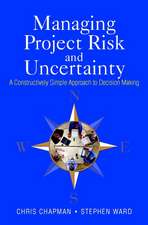Organizational Learning and Knowledge Technologies in a Dynamic Environment
Autor Walter R. J. Baetsen Limba Engleză Paperback – 30 apr 1999
Preț: 646.43 lei
Preț vechi: 760.50 lei
-15% Nou
Puncte Express: 970
Preț estimativ în valută:
123.70€ • 132.27$ • 103.13£
123.70€ • 132.27$ • 103.13£
Carte tipărită la comandă
Livrare economică 18 aprilie-02 mai
Preluare comenzi: 021 569.72.76
Specificații
ISBN-13: 9780792385301
ISBN-10: 0792385306
Pagini: 292
Ilustrații: XIV, 275 p.
Dimensiuni: 160 x 240 x 15 mm
Greutate: 0.59 kg
Ediția:Softcover reprint of the original 1st ed. 1998
Editura: Springer Us
Colecția Springer
Locul publicării:New York, NY, United States
ISBN-10: 0792385306
Pagini: 292
Ilustrații: XIV, 275 p.
Dimensiuni: 160 x 240 x 15 mm
Greutate: 0.59 kg
Ediția:Softcover reprint of the original 1st ed. 1998
Editura: Springer Us
Colecția Springer
Locul publicării:New York, NY, United States
Public țintă
ResearchCuprins
1. The Chaos We Can Observe in Management.- 1.1. Economic phenomena.- 1.2. Information society.- 1.3. Information Technology (IT) evolution: from individual to group IT.- 1.4. Gap between technology and application.- 1.5. Speed of change.- 2. What Can We Learn from Dynamic Behavior of Systems.- 2.1. Dynamic non-linear systems behavior.- 2.2. Far from equilibrium behavior.- 2.3. Computer sciences and knowledge creation: experiments with artificial life.- 2.4. Self-organizing systems.- 2.5. Organizations as neural networks.- 2.6. Artificial Intelligence and genetic programming.- 2.7. Implicit learning.- 2.8. Organizational learning.- 2.9. Tacit knowledge.- 3. About Knowledge, Perceptions and Learning: Managing the Mental Map of a Company.- 3.1. What do we know of managerial processes?.- 3.2. Knowledge and experience.- 3.3. Learning and mental models.- 3.4. Measurement and mapping of mind sets: a connectionist approach.- 3.5. Knowledge is not rule based, but parallel, or how connectionism is positioned against rule based systems.- 3.6. The corporate mental map: what is important ?.- 4. Artificial Intelligence for Knowledge Management and Learning.- 4.1. Artificial Neural Networks.- 4.2. Fuzzy logic.- 4.3. Intelligent systems.- 5. Experiments with Neural Networks.- 5.1. Market response models for fast moving consumer goods.- 5.2. Brand imaging.- 5.3. Introduction strategies in new foreign markets.- 6. Experiments with Complexity and Dynamic Systems.- 6.1. Perception mapping in banking.- 6.2. Client profiles for a more aggressive and better informed front-office.- 6.3. Risk management.- 6.4. Quality management.- 6.5. Dynamic thinking.- 7. IT Support for Organizational Learning: the Organization of Knowledge Networks.- 7.1. The necessary and sufficient conditions for designing and using knowledge networks.- 7.2. The necessary condition for knowledge networks: a learning culture.- 7.3. The sufficient condition for knowledge networks: the integration of Information and Knowledge Technologies.- 7.4. From organized Information Technology to a non-structured emergent knowledge environment: the role of Intranet technologies.- 7.5. The corporate mission: sustainable development via knowledge networks.- 8. A Roadmap of Management in a Dynamic Environment.- Epilogue: Sailing by(E).- Annex: an Epistemological Voyage through Connectionism and Positivism.- (co-authored by Gert van der Linden).- A.1. Science and scientific action.- A.2. The tradition of IS research.- A.3. The ontological and epistemological foundations of neural networks.- A.4. Some comparative properties of artificial neural networks.- Further Readings.- Author Index.

















